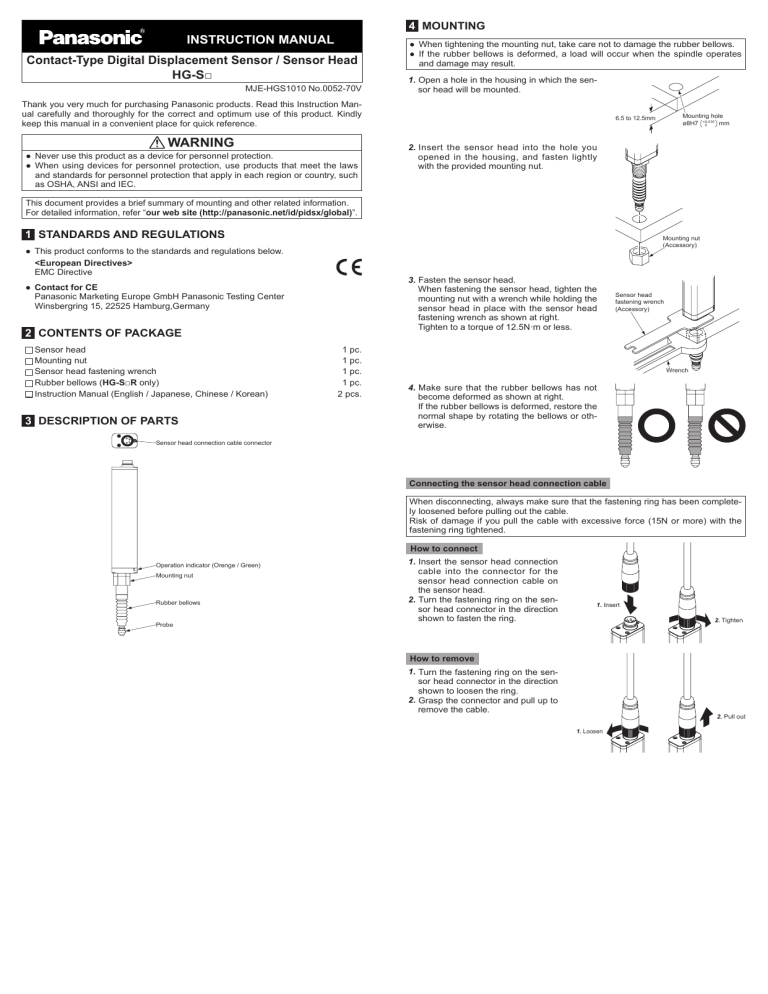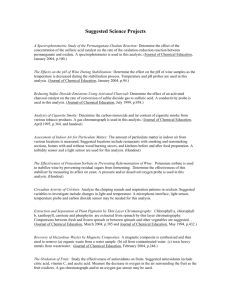HG-S Contact-Type Digital Displacement Sensor/Head, MJE

INSTRUCTION MANUAL
Contact-Type Digital Displacement Sensor / Sensor Head
HG-S□
MJE-HGS1010 No.0052-70V
Thank you very much for purchasing Panasonic products. Read this Instruction Manual carefully and thoroughly for the correct and optimum use of this product. Kindly keep this manual in a convenient place for quick reference.
WARNING
● Never use this product as a device for personnel protection.
● When using devices for personnel protection, use products that meet the laws and standards for personnel protection that apply in each region or country, such as OSHA, ANSI and IEC.
This document provides a brief summary of mounting and other related information.
For detailed information, refer “ our web site (http://panasonic.net/id/pidsx/global) ”.
1
STANDARDS AND REGULATIONS
● This product conforms to the standards and regulations below.
<European Directives>
EMC Directive
● Contact for CE
Panasonic Marketing Europe GmbH Panasonic Testing Center
Winsbergring 15, 22525 Hamburg,Germany
2
CONTENTS OF PACKAGE
Sensor head
Mounting nut
Sensor head fastening wrench
Rubber bellows ( HG-S□R only)
Instruction Manual (English / Japanese, Chinese / Korean)
3
DESCRIPTION OF PARTS
Sensor head connection cable connector
1 pc.
1 pc.
1 pc.
1 pc.
2 pcs.
4
MOUNTING
● When tightening the mounting nut, take care not to damage the rubber bellows.
● If the rubber bellows is deformed, a load will occur when the spindle operates and damage may result.
1. Open a hole in the housing in which the sensor head will be mounted.
6.5 to 12.5mm
Mounting hole
ø8H7 mm
2. Insert the sensor head into the hole you opened in the housing, and fasten lightly with the provided mounting nut.
3. Fasten the sensor head.
When fastening the sensor head, tighten the mounting nut with a wrench while holding the sensor head in place with the sensor head fastening wrench as shown at right.
Tighten to a torque of 12.5N·m or less.
Sensor head fastening wrench
(Accessory)
Mounting nut
(Accessory)
Wrench
4. Make sure that the rubber bellows has not become deformed as shown at right.
If the rubber bellows is deformed, restore the normal shape by rotating the bellows or otherwise.
Operation indicator (Orenge / Green)
Mounting nut
Rubber bellows
Probe
Connecting the sensor head connection cable
When disconnecting, always make sure that the fastening ring has been completely loosened before pulling out the cable.
Risk of damage if you pull the cable with excessive force (15N or more) with the fastening ring tightened.
How to connect
1. Insert the sensor head connection cable into the connector for the sensor head connection cable on the sensor head.
2. Turn the fastening ring on the sensor head connector in the direction shown to fasten the ring.
1.
Insert
2.
Tighten
How to remove
1. Turn the fastening ring on the sensor head connector in the direction shown to loosen the ring.
2. Grasp the connector and pull up to remove the cable.
1.
Loosen
2.
Pull out
5
SPECIFICATIONS
Type
Model No.
Position detection method
Measurement range (Note 2)
Stroke (Note 2)
Measuring force
Resolution
Downward mount
Upward mount
Hot swap function
Protective structure
Ambient temperature
Ambient humidity
Mechanical life (Note 6)
Tip deviation amount
Grounding method
Material
Side mount
Indication accuracy (P-P)
General purpose
Standard type
HG-S1010
Low measuring force type
HG-S1010R
High precision
Standard type
HG-S1110
Optical absolute linear encoder method
10mm
Low measuring force type
HG-S1110R
1.65N or less
1.1N (Note 3)
1.35N or less
0.85N (Note 3)
1.5N or less
0.95N (Note 3)
10.5mm or more
0.35N or less (Note 4)
0.3N (Note 3, 4)
1.65N or less
1.1N (Note 3)
0.12N or less (Note 4)
0.05N (Note 3, 4)
0.25N or less (Note 4)
0.2N (Note 3, 4)
1.35N or less
0.85N (Note3)
1.5N or less
0.95N (Note 3)
0.35N or less (Note 4)
0.3N (Note 3, 4)
0.12N or less (Note 4)
0.05N (Note 3, 4)
0.25N or less (Note 4)
0.2N (Note 3, 4)
0.5µm
• Full range: 2.0µm or less
• Limited range: 1.0µm or less (any 60µm)
0.1µm
• Full range: 1.0µm or less
• Limited range: 0.5µm or less (any 60µm)
IP67 (IEC) (Note 5) -
Incorporated
IP67 (IEC) (Note 5) -
-10 to +55°C (No dew condensation or icing allowed), Storage: -20 to +60°C
35 to 85% RH, Storage: 35 to 85% RH
100 million times or more (reference value)
35µm (typical value)
Capacitor grounding
Body: Zinc, Holder: Stainless steel, Spindle: Tool steel
Probe: Ceramic, Rubber bellows: NBR (black)
Approx. 80g Weight (main unit only)
Notes: 1) Measured at an ambient temperature of +20°C, unless otherwise specified.
2) 5 to 10mm range when HG-S□R is mounted in upward mount.
3) Typical value near center of measurement.
4) Standard state without the rubber bellows.
5) Excludes damage and deterioration to the rubber bellows due to external causes.
6) Typical value in a clean environment in which there is no contact with liquids such as water or oil, and no settling of particulate matter.
When the HG-S□R is installed in the upward orientation, 4 million times (typical value).
6
CAUTIONS
The special sensor head HG-S□ is designed to be used with the controller
HG-SC□.
If used with other than the special sensor head option, the specifications will not be met and product malfunctioning or damage may occur.
● This device has been developed / produced for industrial use only.
● Do not use this product outside the range of the specifications. Risk of an accident and product damage. There is also a risk of a noticeable reduction of service life.
● Deviations may occur in the measured value at the bottom dead point. Do not use the bottom dead point as a standard.
● Do not wire in parallel with a high-voltage line or power line, or run through the same conduit. Risk malfunctioning due to induction.
● Verify that the supply voltage fluctuations are within the rating.
● If power is supplied from a commercial switching regulator, ensure that the frame ground (F.G.) terminal of the power supply is connected to an actual ground.
● Do not use during the initial transient time after the power supply is switched ON.
● Do not apply stress such as excessive bending or pulling to the extracted part of a cable.
● This product is suitable for indoor use only.
● Avoid dust, dirt, and steam.
● Do not use this sensor in places where it may come in contact with corrosive gas, etc.
● Ensure that the product does not come into contact with organic solvents such as thinner.
● Ensure that the product does not come into contact with strong acid or alkaline.
● Ensure that the product does not come into contact with oil or grease.
● This product cannot be used in an environment containing flammable or explosive gases.
● Performance may not be satisfactory in a strong electromagnetic field.
● This product is a precision device. Do not drop or otherwise subject to shock. Risk of product damage.
● Never remove the standard rubber bellows except for replacement.
Risk of product damage due to infiltration by dust, water, or other contaminants.
● When the product becomes unusable or unneeded, dispose of the product appropriately as industrial waste.
● Never attempt to disassemble, repair, or modify the product.
7
MAINTENANCE
How to replace the probe
● Always secure the spindle to prevent rotation before replacing the probe. Risk of product damage if an excessive torque (0.2N·m or more) is applied to the spindle.
● If the rubber bellows is damaged or deformed during probe replacement, the specifications of the protective structure may not be satisfied.
1. Turn the probe screw in the direction of the arrow and remove the probe from the spindle. When turning the probe screw, hold the cut face of the spindle with the provided sensor head fastening wrench to prevent the spindle from turning.
Hold the sensor head fastening wrench in place, and turn only the probe.
Sensor head fastening wrench
(Accessory)
Probe
Turn
2. Attach the new probe to the spindle. The tightening torque should be 0.4N·m or less. Make sure that the probe does not come OFF.
When turning the probe screw, hold the cut face of the spindle with the provided sensor head fastening wrench to prevent the spindle from turning.
Hold the sensor head fastening wrench in place, and turn only the probe.
Turn
3. After attaching the probe, wipe the spindle with absolute alcohol to remove any dirt.
How to replace the rubber bellows
● When replacing the rubber bellows, take care that no dirt or other contaminants get on the spindle. Risk of malfunctioning. If any dirt gets on the spindle, wipe clean with absolute alcohol. Do not allow the rubber bellows to become twisted during attachment.
● Note that the measuring force will vary depending on the attachment state of the rubber bellows.
● If the rubber bellows is deformed, a load will occur when the spindle operates and damage may result.
1. Turn the probe screw in the direction of the arrow and remove the probe from the spindle. When turning the probe screw, hold the cut face of the spindle with the provided sensor head fastening wrench to prevent the spindle from turning.
Hold the sensor head fastening wrench in place, and turn only the probe.
Sensor head fastening wrench
(Accessory)
Probe
Turn
2. Remove the rubber bellows from the spindle.
3. Fit the new rubber bellows onto the spindle.
Insert to the top edge of the spindle as shown at right.
Rubber bellows (Option)
Insert to top edge
4. Push the rubber bellows up with your finger until the tip of the spindle is exposed as shown at right.
5. Attach the probe to the spindle. The tightening torque should be 0.4N·m or less. Make sure that the probe does not come OFF.
When turning the probe screw, hold the cut face of the spindle with the provided sensor head fastening wrench to prevent the spindle from turning.
Hold the sensor head fastening wrench in place, and turn only the probe.
6. Make sure that the rubber bellows has not become deformed as shown at right.
If the rubber bellows is deformed, restore the normal shape by rotating the bellows or otherwise.
Turn
Spindle tip http://panasonic.net/id/pidsx/global
Overseas Sales Division (Head Office)
2431-1 Ushiyama-cho, Kasugai-shi, Aichi, 486-0901, Japan
Phone: +81-568-33-7861 FAX: +81-568-33-8591
For sales network, please visit our website.
PRINTED IN JAPAN © Panasonic Industrial Devices SUNX Co., Ltd. 2015

